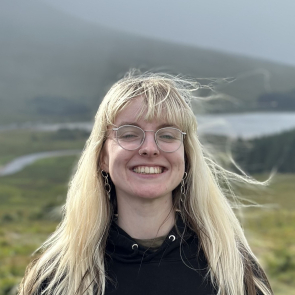You are here
- Home
- Plumes, PhDs and Planetary Simulations
Plumes, PhDs and Planetary Simulations
This is the story about how saying yes to opportunities can lead to the highlight of your career so far, and even a chapter in my future thesis (yes, really!)
I'm Jessie, a first year PhD student who joined the OU in October - and what a wild few months it has been. My project has already shape-shifted since reading, writing, and experimenting, which is to be expected - but nothing I've done in my PhD so far has come close to the week I spent at Aarhus University using their colossal wind tunnel to form part of my Enceladus plume research.
Guided by icy moon experts, Rachael Hamp and Mark Fox-Powell, we set off to Denmark at 5am on a cold and rainy Sunday morning. Rachael and I kicked off experiments at 8am sharp the following morning - where we had to get to grips with our new home for the next 5 days and our new piece of kit to play with. The wind tunnel itself is a massive 40m3 in volume, and 10m long by 2.3m wide - with the capabilities to simulate various planetary conditions to study the behaviour of dust grains. Our project was focused on using the tunnel at various pressures to simulate the behaviour of icy grains in Enceladus analogue conditions, but the possibilities go far beyond this.
You can find more about the tunnel and its applications here. I highly recommend the facilities and of course Jon and Jacob, the friendly, tea-drinking duo that are behind the science that happens there!
.jpeg) So, it begins… Day 1:
So, it begins… Day 1:
We went in with a loose plan, ready to adapt in the event our experiment didn't quite go as planned. Regardless, day 1 was a huge success - we managed to do 25 ‘run-throughs’ in the chamber, which already gave us a whole host of data to work through. We were off to a great start! On a high from the first day, we went into day 2 with high hopes, only to find that tinkering with our set-up inside the chamber and getting the high-speed camera to function at its best was pretty challenging to say the least, taking out most of the day.
Nevertheless, the experiments got back on track throughout the week as we got to learn more about the chamber, it's limits, it's quirks; meaning we managed to get a system in place where it worked like clockwork. The data came in ebbs and flows, and we had to make the all-important science decisions about repeatability, compromising on data quantity for quality and problem-solving on our feet such as when the injector blocked with our salty water (sorry about the mess, Jon)! All in all, I learned a lot about how science experiments work in the field, with only a set amount of time to gain usable data that fit your original science aims. It also gave me the chance to understand the operation of a planetary simulation chamber, exercise my knowledge of Enceladus' conditions, pick the brains of others in the field, as well as a whole host of science ideas.
It looks like my next couple of months will be behind a computer screen, working hard to sort through, plot and analyse some data - I’m really looking forward finding out what comes from the trip and ultimately, what this means for salty-ice grains forming at Enceladus.
Finally, I would like to thank Dr. Rachael Hamp and Dr. Mark Fox-Powell for offering me the chance to work on this and for believing in me to take a lead role on this project
.jpeg)
